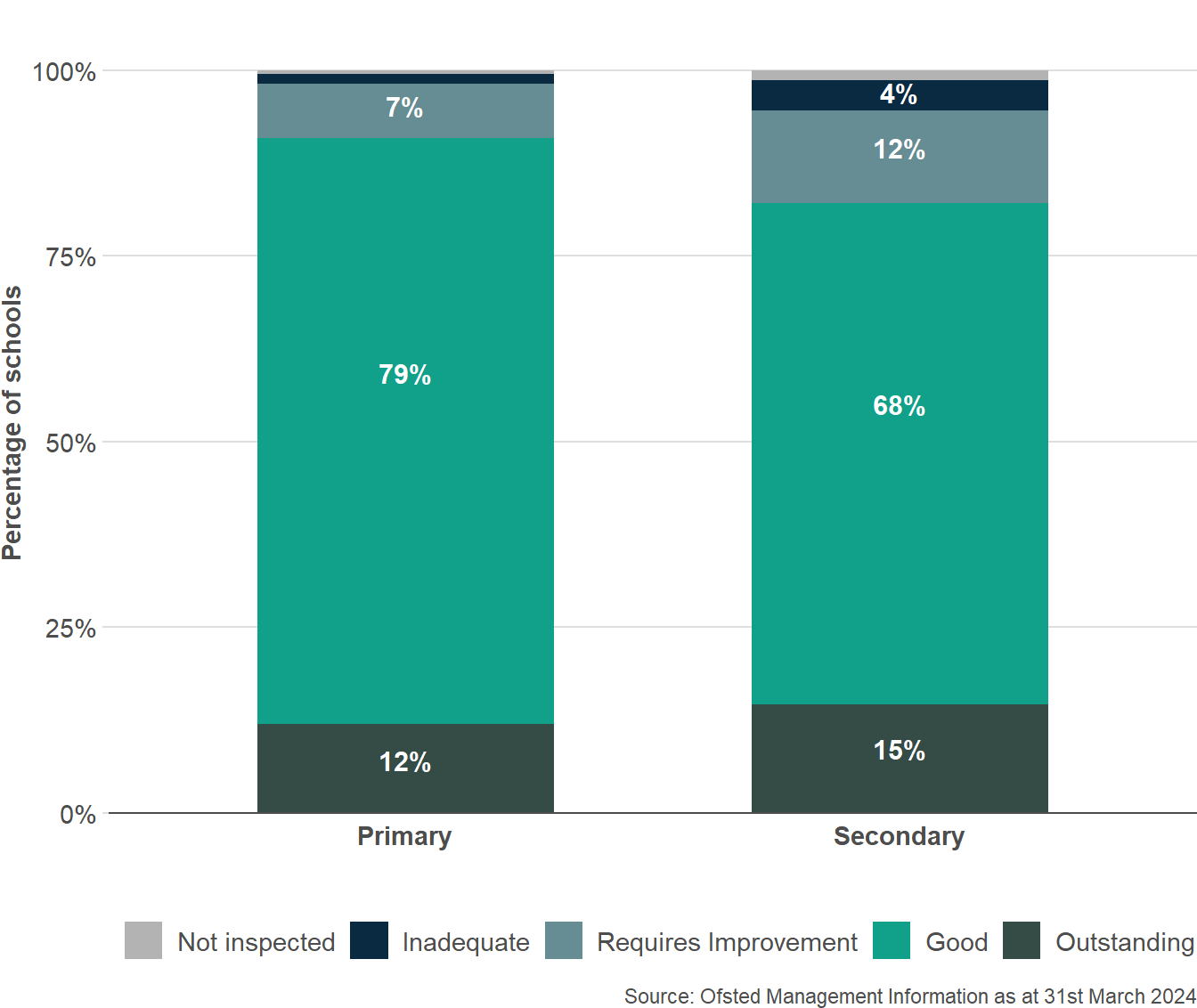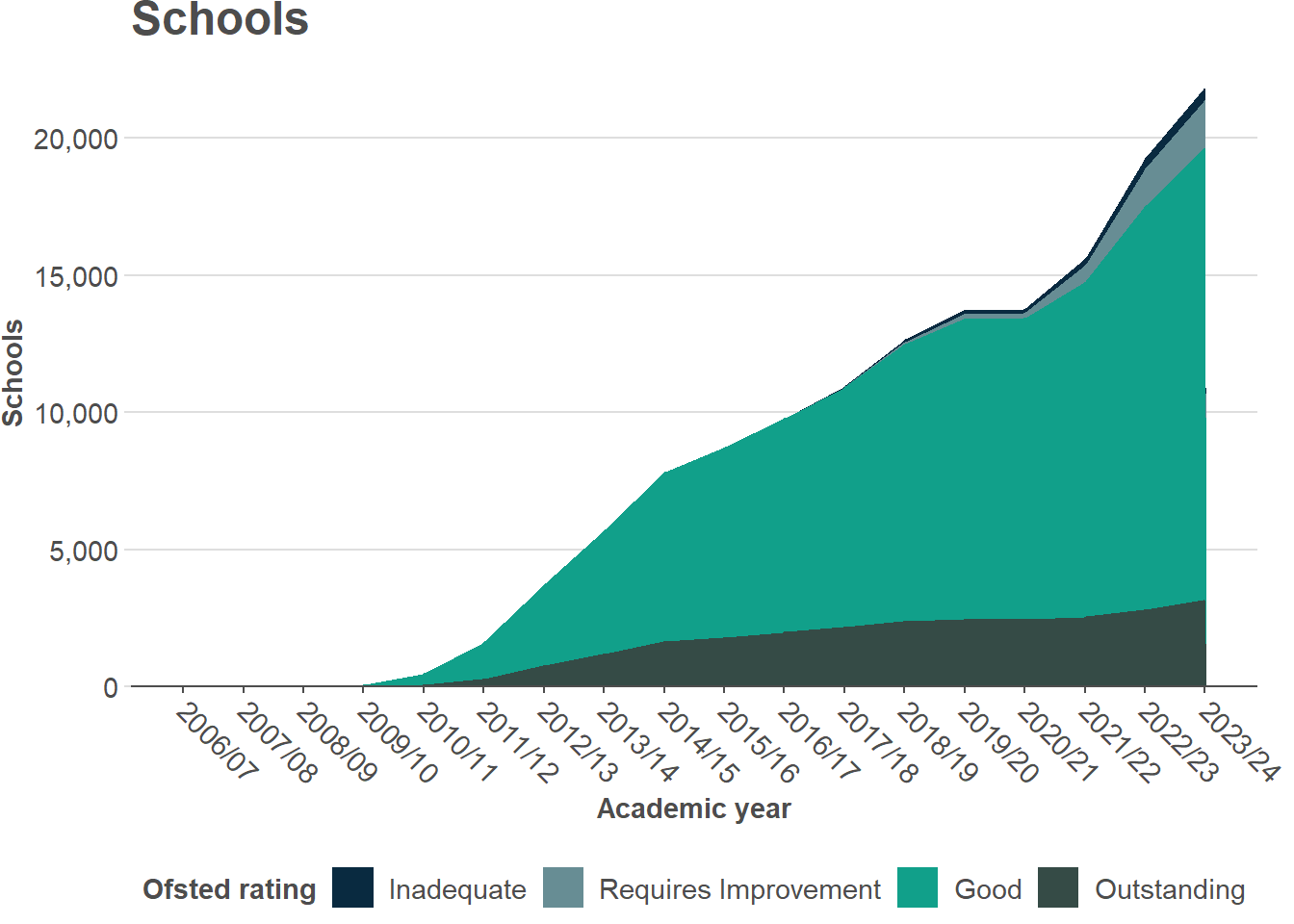The Department for Education routinely uses the statistic:
“90% of schools are now rated Good or Outstanding, up from 68% in 2010”
This claim is, perhaps unsurprisingly, true.
We expect such government lines to be factually accurate, after all there is an army of civil servants rigorously checking and re-checking these statistics before they are stated in public. So it is true; 68% of schools were Good or Outstanding at the end of the 2009/10 academic year, and at the end of the 2022/23 academic year this figure was 89%. However, as with all such simple headlines there is a lot more nuance hiding behind it.
In the following short piece I uncover some of this nuance and show why we should be careful in how we go about interpreting DfE’s headline claim. Particularly with regard to the implication of such a statement, that school standards have therefore improved over this period. This short blog focuses on exploring the veracity of the claim, not the more fundamental question of whether one-word Ofsted judgements are a fair and accurate why of assessing school performance.
Figure 1 shows the percentage of schools with each Ofsted grade at the end of each school year since 2009/10.

The first omission of the headline figure is that whilst the percentage of Good or Outstanding schools combined has steadily increased over the period, the percentage of Outstanding schools has actually fallen from 18% to 16% since 2010. Table 1 shows the most recent data as of March 31st 2024. This shows the fraction of Outstanding schools continues to fall. Today there are a third less Outstanding schools (14%) compared to a peak in 2016/17 and 2017/18 (21%). However, it should be noted that between 2012 and 2020, schools that had been judged Outstanding were legally exempt from further regular inspection, unless there were specific concerns about the school.
| Schools | Pupils | |||
|---|---|---|---|---|
| Number | Percent | Number | Percent | |
| Outstanding | 3,155 | 14% | 1,358,160 | 16% |
| Good | 16,481 | 75% | 6,057,251 | 73% |
| 19,636 | 89% | 7,415,411 | 90% | |
| Requires Improvement | 1,759 | 8% | 680,738 | 8% |
| Inadequate | 425 | 2% | 152,218 | 2% |
| Not inspected | 177 | 1% | 21,632 | 0% |
| 2,361 | 11% | 854,588 | 10% | |
| Source: Ofsted Management Information as at 31st March 2024 | ||||

Figure 2 shows there is also variation across phase. The headline therefore hides that whilst 91% of Primary schools are currently rated Good or Outstanding, this is true of only 83% of Secondary schools. However, a greater percentage of Secondary schools are currently rated Outstanding (15%) compared to Primary schools (12%).
The headline also does not touch on how long has it been since schools were last inspected?
This is important because if schools have not been inspected for a long time, we can not be sure that the ratings are an accurate reflection of performance today.
Whilst the exemption on inspecting Outstanding schools was lifted in 2020, many Outstanding, and even Good schools, have not been inspected for a long time. Table 2 shows that on average, schools currently rated Outstanding were last inspected 7.3 years ago. Schools currently rated Good have typically been inspected more recently, but still on average they were last inspected 6.1 years ago.
| Average days since last inspection |
Average date of last inspection |
|
|---|---|---|
| Outstanding | 2,669 | 2016-12-09 |
| Good | 2,209 | 2018-03-14 |
| Requires Improvement | 556 | 2022-09-22 |
| Inadequate | 928 | 2021-09-15 |
| Source: Ofsted Management Information as at 31st March 2024 | ||
Admittedly, only very few (68) Good or Outstanding schools have not been inspected since 2010, the year the headline figure refers to. However, 38% of currently Outstanding schools and 27% of currently Good schools have not been inspected in the last 10 years.
That means that around 1.9 million, or almost 1 in 4, pupils currently attend a Good or Outstanding school that has not been inspected in the last 10 years.


| Schools | Pupils | |||
|---|---|---|---|---|
| Number | Percent | Number | Percent | |
| 2009/10 | ||||
| Outstanding | 50 | 2% | 15,581 | 1% |
| Good | 18 | 0% | 5,619 | 0% |
| 2013/14 | ||||
| Outstanding | 1,194 | 38% | 429,471 | 32% |
| Good | 4,502 | 27% | 1,447,242 | 24% |
| Source: Ofsted Management Information as at 31st March 2024 | ||||
This still begs the question; is it really a problem that these schools have not been inspected for such a long time?
Over the last 10 years, 2,713 Outstanding schools have been inspected. Table 4 shows the outcomes of the inspections of these schools. Of these previously Outstanding schools, only 28% retained their Outstanding rating. Taken together with the relatively high fraction of schools that have not been inspected in the last 10 years, this suggests the headline figure could be a misleading representation of the true performance of schools today.
| Schools | Pupils | |||
|---|---|---|---|---|
| Number | Percent | Number | Percent | |
| Outstanding | 748 | 28% | 416,897 | 33% |
| Good | 1,741 | 64% | 742,989 | 60% |
| Requires Improvement | 185 | 7% | 73,951 | 6% |
| Inadequate | 39 | 1% | 12,492 | 1% |
| Total | 2,713 | 100% | 1,246,329 | 100% |
| Source: Ofsted Management Information as at 31st March 2024 | ||||
Another potential challenge to the headline figures is that 3,389 schools have undergone academisation or been re-brokered since their last Ofsted inspection. These changes often go hand in hand with significant changes in school governance structures, and so the Ofsted grades of these schools may not be a good reflection of their performance today. Table 5 shows that around 15% of currently Good or Outstanding schools have academised or been re-brokered since their last Ofsted inspection.
| Schools | Pupils | |||
|---|---|---|---|---|
| Number | Percent | Number | Percent | |
| Outstanding | 476 | 15% | 147,848 | 11% |
| Good | 2,408 | 15% | 701,349 | 12% |
| Requires Improvement | 236 | 13% | 32,867 | 5% |
| Inadequate | 269 | 63% | 72,726 | 48% |
| Source: Ofsted Management Information as at 31st March 2024 | ||||
So, all in all, whilst the DfE’s headline is factually correct, it hides a lot if we want to understand whether this means school standards have improved. I have shown that:
The fraction of Outstanding schools appears to be falling and is less than in 2010.
Only 83% of Secondary schools are Good or Outstanding.
Ofsted grades may not be a good reflection of current performance;
The average Outstanding school hasn’t been inspected for over 7 years and the average Good school for 6 years. Important as we know re-inspection of Outstanding schools often leads to a change in grade.
15% of currently Good or Outstanding schools are operating under different governance arrangements to when they were last inspected.